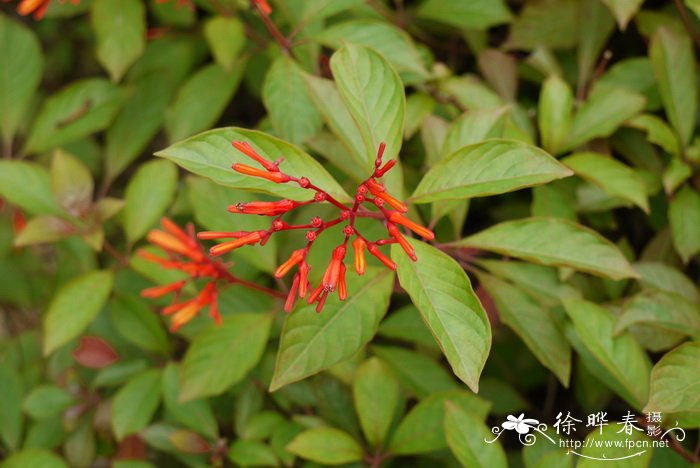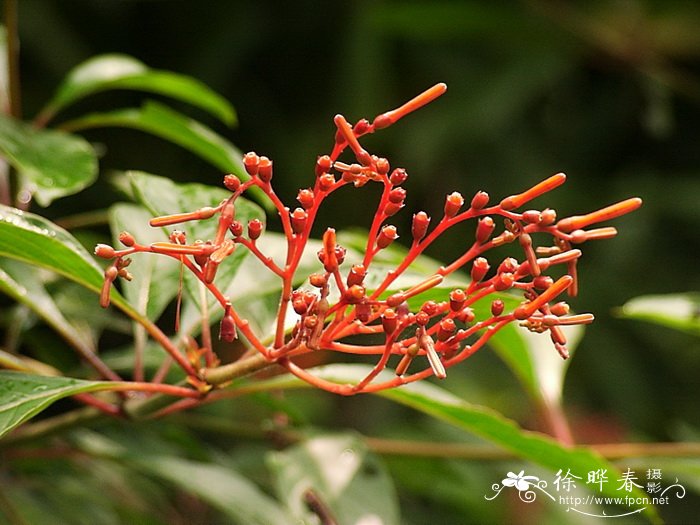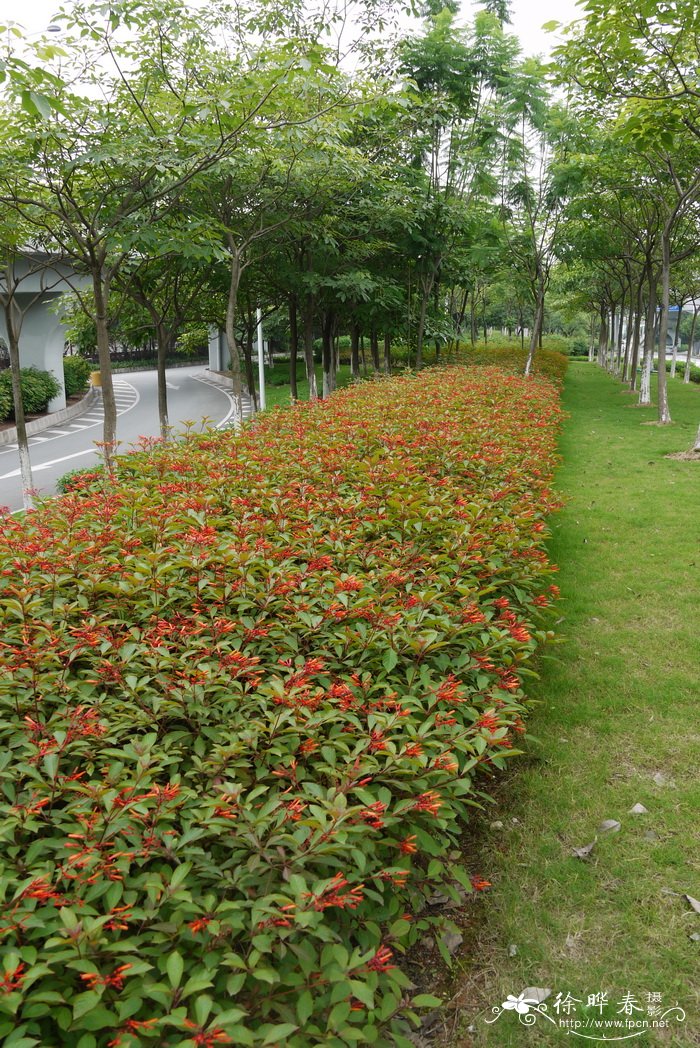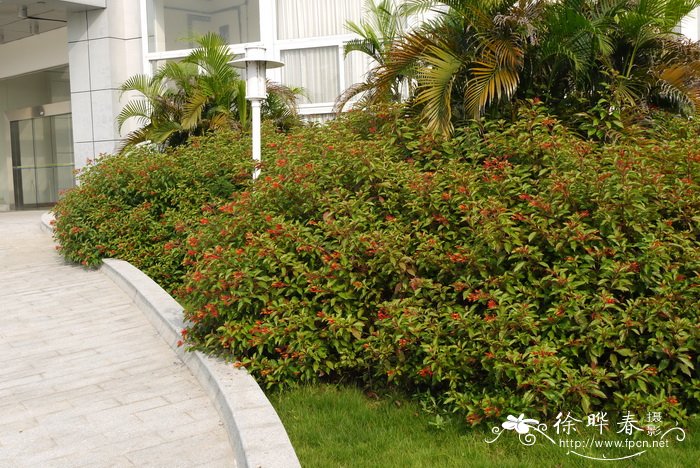希茉莉Hamelia patens
中文名(Chinese Name):希茉莉
学名(Scientific Name):Hamelia patens Jacq.
英文名(English Common Name):scarletbush
别名(Chinese Common Name):长隔木
异名(Synonym):Duhamelia patens (Jacq.) Pers. Hamelia patens var. axillaroides Wernham Schoenleinia thyrsoidea Miers
科属(Family & Genus):茜草科(Rubiaceae)长隔木属
形态特征(Description):红色灌木,高2-4米,嫩部均被灰色短柔毛。叶通常3枚轮生,椭圆状卵形至长圆形,长7-20厘米,顶端短尖或渐尖。聚伞花序有3-5个放射状分枝;花无梗,沿着花序分枝的一侧着生;萼裂片短,三角形;花冠橙红色,冠管狭圆筒状,长1.8-2厘米;雄蕊稍伸出。浆果卵圆状,直径6-7毫米,暗红色或紫色。
分布(Distribution):原产巴拉圭等拉丁美洲各国,我国南部和西南部有栽培。
用途(Use):
引自中国植物志英文版:FOC Vol. 19 Page 147
Hamelia patens Jacquin, Enum. Syst. Pl. 16. 1760.
长隔木 chang ge mu| Rubiaceae | Hamelia
Shrubs, deciduous, 1.5-4 m tall; branches angled to subterete, often becoming red, hirtellous or pilosulous to glabrescent. Leaves 2, 3, or 4(or 5) per node; petiole 1.5-4.5 cm, pilosulous or hirtellous to glabrous; blade drying papery to membranous, elliptic to oblanceolate, 7-20 × 4-6 cm, both surfaces pilosulous or hirtellous to glabrescent, base cuneate to acute, apex acute to weakly acuminate; secondary veins 7-9 pairs, in abaxial axils frequently with pilosulous domatia; stipules narrowly triangular to subulate, 2-6 mm, hirtellous or pilosulous to glabrescent. Inflorescences corymbiform, villosulous or pilosulous to glabrescent; peduncle 1-8 cm; branched portion corymbiform, 1.5-7 × 1.5-9 cm; bracts reduced or triangular, 0.2-0.5 mm. Flowers subsessile to pedicellate; pedicels to 2 mm. Calyx hirtellous to glabrous; ovary portion ellipsoid, ca. 3 mm; limb deeply lobed; lobes triangular, 0.8-1 mm. Corolla red to red-orange or yellow, narrowly tubular, outside puberulent to glabrous; tube smooth to shallowly 5-ribbed, 16-23 mm; lobes ovate-triangular, 1-2 mm, acute. Berry ovoid, 6-7 mm in diam., puberulent to glabrescent. Fl. May-Dec.
Cultivated in gardens in Fujian, Yunnan [native and weedy in Mexico, United States (Florida), and the Caribbean region, Central America, and tropical South America; cultivated as a perennial in tropical regions and an annual or indoors in temperate regions worldwide].
In S China and in cultivation in general this species does not set fruit; the fruit description here is based on wild plants. The flowers of the cultivated plants range from yellow to dark scarlet red, and in recent years many new cultivars have been developed.




(责任编辑:徐晔春)
学名(Scientific Name):Hamelia patens Jacq.
英文名(English Common Name):scarletbush
别名(Chinese Common Name):长隔木
异名(Synonym):Duhamelia patens (Jacq.) Pers. Hamelia patens var. axillaroides Wernham Schoenleinia thyrsoidea Miers
科属(Family & Genus):茜草科(Rubiaceae)长隔木属
形态特征(Description):红色灌木,高2-4米,嫩部均被灰色短柔毛。叶通常3枚轮生,椭圆状卵形至长圆形,长7-20厘米,顶端短尖或渐尖。聚伞花序有3-5个放射状分枝;花无梗,沿着花序分枝的一侧着生;萼裂片短,三角形;花冠橙红色,冠管狭圆筒状,长1.8-2厘米;雄蕊稍伸出。浆果卵圆状,直径6-7毫米,暗红色或紫色。
分布(Distribution):原产巴拉圭等拉丁美洲各国,我国南部和西南部有栽培。
用途(Use):
引自中国植物志英文版:FOC Vol. 19 Page 147
Hamelia patens Jacquin, Enum. Syst. Pl. 16. 1760.
长隔木 chang ge mu| Rubiaceae | Hamelia
Shrubs, deciduous, 1.5-4 m tall; branches angled to subterete, often becoming red, hirtellous or pilosulous to glabrescent. Leaves 2, 3, or 4(or 5) per node; petiole 1.5-4.5 cm, pilosulous or hirtellous to glabrous; blade drying papery to membranous, elliptic to oblanceolate, 7-20 × 4-6 cm, both surfaces pilosulous or hirtellous to glabrescent, base cuneate to acute, apex acute to weakly acuminate; secondary veins 7-9 pairs, in abaxial axils frequently with pilosulous domatia; stipules narrowly triangular to subulate, 2-6 mm, hirtellous or pilosulous to glabrescent. Inflorescences corymbiform, villosulous or pilosulous to glabrescent; peduncle 1-8 cm; branched portion corymbiform, 1.5-7 × 1.5-9 cm; bracts reduced or triangular, 0.2-0.5 mm. Flowers subsessile to pedicellate; pedicels to 2 mm. Calyx hirtellous to glabrous; ovary portion ellipsoid, ca. 3 mm; limb deeply lobed; lobes triangular, 0.8-1 mm. Corolla red to red-orange or yellow, narrowly tubular, outside puberulent to glabrous; tube smooth to shallowly 5-ribbed, 16-23 mm; lobes ovate-triangular, 1-2 mm, acute. Berry ovoid, 6-7 mm in diam., puberulent to glabrescent. Fl. May-Dec.
Cultivated in gardens in Fujian, Yunnan [native and weedy in Mexico, United States (Florida), and the Caribbean region, Central America, and tropical South America; cultivated as a perennial in tropical regions and an annual or indoors in temperate regions worldwide].
In S China and in cultivation in general this species does not set fruit; the fruit description here is based on wild plants. The flowers of the cultivated plants range from yellow to dark scarlet red, and in recent years many new cultivars have been developed.
(责任编辑:徐晔春)
踩一下[0]

顶一下[6]